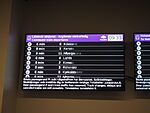Swedish-speaking population of Finland facts for kids
|
|
|---|---|

Flag of the Swedish-speaking Finns
|
|
| Total population | |
| 380,000 | |
| Regions with significant populations | |
| 287,933 (2021) | |
| 60,000–107,000 | |
| Languages | |
| Finland Swedish, Finnish | |
| Religion | |
| Lutheranism | |
| Related ethnic groups | |
| Swedes, Estonian Swedes | |

More than 17,000 Swedish-speaking Finns live in officially monolingual Finnish municipalities, and are thus not represented on the map.
The Swedish-speaking population of Finland is a group of people in Finland who speak Swedish as their main language. They are a minority group, but they have a strong sense of who they are. They are sometimes called Finland-Swedes or Swedish Finns. They speak a form of Swedish called Finland Swedish. This language is similar to the Swedish spoken in Sweden.
About 260,000 people in mainland Finland speak Swedish as their first language. Another 26,000 live in Åland, a group of islands where most people speak Swedish. In total, Swedish speakers make up about 5.2% of Finland's population. This number has slowly gone down over time. In the early 1800s, about 15% of people in Finland spoke Swedish.
Even though the percentage has dropped, the total number of Swedish speakers might be growing. This is because more families where one parent speaks Swedish and the other speaks Finnish are choosing to raise their children as Swedish speakers. About 70% of these mixed families register their children as Swedish-speaking.
Contents
Understanding the Names for This Group
The group itself uses the Swedish term finlandssvenskar, which means 'Finland's-Swedes'. In English, they are often called the "Swedish-speaking population of Finland." Other names you might hear are "Finland-Swedes" or "Swedish Finns."
Some people prefer "Finland-Swedes" because they feel it shows their connection to Sweden. Others use "Swedish-speaking Finns" to highlight that they are part of Finland. No matter the name, they are a unique part of Finland's culture.
A Look at Their History
Early Swedish Settlements in Finland
Swedish people first came to Finland a long time ago, around the 1100s. This was when Sweden was expanding and spreading Christianity. People from Sweden also moved to Finland because there was more land available. They settled in the southern and western coastal areas.
Later, in the 13th and 14th centuries, more Swedes arrived. They came in large groups from different parts of Sweden. The Swedish government even encouraged them to move to Finland. This led to many Swedish settlements along the coasts of Finland.
How Did the Swedish Language Become Important?
For about 550 years, Finland was part of the Swedish kingdom. During this time, Swedish became the language of important people like nobles, government officials, and teachers. This meant that if you wanted to be powerful or get a good education, you often needed to speak Swedish.
Even though Swedish was important, many priests learned Finnish so they could speak with people in Finnish-speaking areas. Also, many wealthy business people in cities like Turku were of German origin, but they often learned Swedish too.
Finland Becomes Part of Russia
In 1809, Sweden lost Finland to Russia. Finland became a special area called the Grand Duchy of Finland. During this time, Russian leaders wanted to make Finland less connected to Sweden. So, they started to promote the Finnish language. This helped Finnish become more important in government and culture.
Many educated people, even those from Swedish-speaking families, started to learn Finnish and change their names to Finnish ones. They believed this would help Finland become a stronger nation. This period was called the "language strife" because there were strong disagreements about which language should be most important.
Changes Over Time
Over the 19th and 20th centuries, the number of Swedish speakers in Finland slowly decreased. In 1900, about 12.9% of Finland's population spoke Swedish. By 1990, this had fallen to 5.9%. This was partly because many Swedish speakers moved to Sweden.
However, in recent years, this decline has slowed down. More families are choosing to raise their children as Swedish speakers. This is often because knowing both Swedish and Finnish can be helpful for jobs in Finland.
Culture and Arts
The Swedish-speaking Finns have a rich culture. Their traditional stories often involve the sea, as many lived along the coast. These stories are similar to those found in other Nordic countries.
They also have famous writers and artists. Edith Södergran was a very important poet in the early 1900s. Another famous writer is Tove Jansson, who created the beloved Moomin books. These books are popular with children and adults all over the world.
Every year on November 6th, Finland celebrates Finnish Swedish Heritage Day. This day honors the Swedish-speaking population, their culture, and the fact that Finland is a bilingual country.
Identity and Belonging
Swedish-speaking Finns have their own unique identity. They see themselves as different from the Finnish-speaking majority. They want to be recognized as a distinct group.
When Swedish-speaking Finns talk about all Finnish citizens (both Swedish and Finnish speakers), they often use the Swedish word finländare. This word means 'Finlanders' and includes everyone. They do this because the word finnar (Finns) often means only Finnish-speaking Finns in their language.
It's very common for Swedish-speaking and Finnish-speaking people to marry each other today. Many of these families choose to register their children as Swedish-speaking. This helps keep the Swedish language alive in Finland.
Finland's Bilingual System
Finland's constitution says it is a bilingual country. This means that Swedish speakers have the right to use Swedish when they talk to government offices.
Towns and cities in Finland are either monolingual (one language) or bilingual (two languages). A place becomes bilingual if at least 8% of its population speaks the minority language. In bilingual areas, public signs, like street signs, are in both Finnish and Swedish. The name in the majority language is usually on top.
In schools, both Swedish and Finnish are compulsory subjects. Students learn their "mother tongue" (their main language) and the "other domestic language." This helps students become bilingual and work in different parts of Finland. Swedish-speaking Finns are often very good at Finnish because they live in a country where Finnish is the main language.
Where Swedish Speakers Live in Finland
Most Swedish-speaking Finns live in areas where Swedish is either the main language or one of the official languages.
- 44% live in bilingual towns where Finnish is more common.
- 41% live in bilingual towns where Swedish is more common.
- 9% live in Åland, where about 90% of people speak Swedish.
- 6% live in areas where only Finnish is the official language.
Swedish-Speaking Immigrants
Finland also has a small number of immigrants who speak Swedish. Many come from Sweden. Others choose Swedish because it's the main language in their city or because their partner speaks Swedish. Some immigrants feel it's easier to fit into the Swedish-speaking community than the Finnish-speaking one.
Swedish Speakers Around the World
Many Swedish-speaking Finns have moved to other countries. Between the 1870s and 1920s, about 70,000 moved to North America. Some settled in places like Minnesota in the United States.
Sweden has always been the most popular country for them to move to. Over half of Swedish-speaking Finns who move abroad go to Sweden. There are about 200,000 Swedish-speaking Finns living in Sweden today. Sometimes, their accent or way of speaking Finland Swedish can be different from Swedish spoken in Sweden.
Famous Swedish-Speaking Finns
Many famous people from Finland have been Swedish-speaking. Here are just a few:
- Tove Jansson, who wrote the Moomin books.
- Jean Sibelius, a world-famous classical composer.
- Carl Gustaf Emil Mannerheim, a military leader and former President of Finland.
- Linus Torvalds, who created the Linux kernel, a very important computer program.
- Alexander Stubb, a former Prime Minister and current President of Finland.
- Lars Ahlfors, mathematician
- Antti Ahlström, industrialist
- Gustaf Mauritz Armfelt, diplomat
- Niklas Bäckström, ice hockey goaltender
- Jörn Donner, writer and film director
- Albert Edelfelt, painter
- Karl-August Fagerholm, former Prime Minister of Finland
- Kaj Franck, designer
- Ragnar Granit, scientist and Nobel laureate
- Marcus Grönholm, rally driver
- Bengt Holmström, Nobel laureate in economic sciences
- Fredrik Idestam, founder of Nokia
- Tove Jansson, writer and illustrator
- Pernilla Karlsson, singer
- Linda Lampenius, classical violinist
- Kevin Lankinen, ice hockey goaltender
- Magnus Lindberg, composer
- Isak Elliot Lundén, singer-songwriter
- Carl Gustaf Mannerheim, Marshal and President of Finland
- Adolf Erik Nordenskiöld, Arctic explorer
- Gunnar Nordström, physicist
- Paradise Oskar, singer-songwriter
- Kebu, keyboard player
- Johan Ludvig Runeberg, Finland's national poet
- Helene Schjerfbeck, painter
- André Linman, musician
- Jean Sibelius, classical composer
- Krista Siegfrids, pop musician
- Johan Vilhelm Snellman, philosopher and statesman
- Lars Sonck, architect
- Tim Sparv, former national football team captain
- Kaarlo Juho Ståhlberg, 1st President of Finland
- Pehr Evind Svinhufvud, 3rd President of Finland
- Edith Södergran, modernist poet
- Eric Tigerstedt, inventor
- Zacharias Topelius, journalist and author
- Linus Torvalds, software engineer
- Michael Widenius, software programmer (MySQL)
- Alexander Stubb, former Prime Minister and President of Finland
Images for kids









